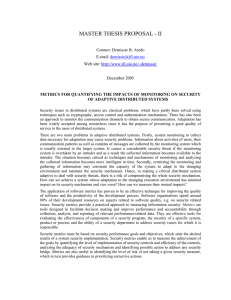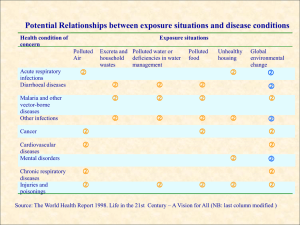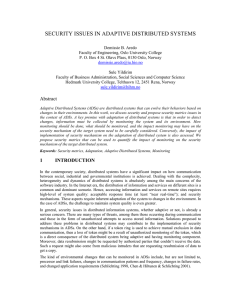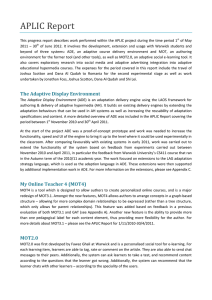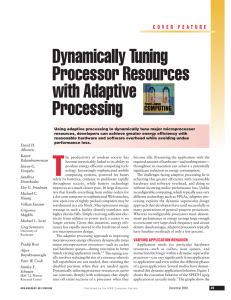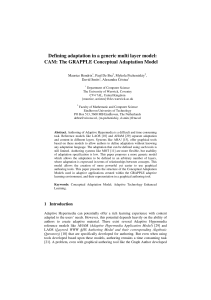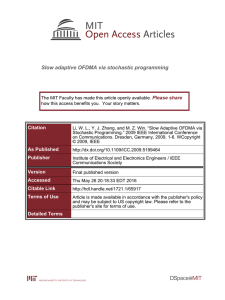MASTER THESIS PROPOSAL - I
advertisement
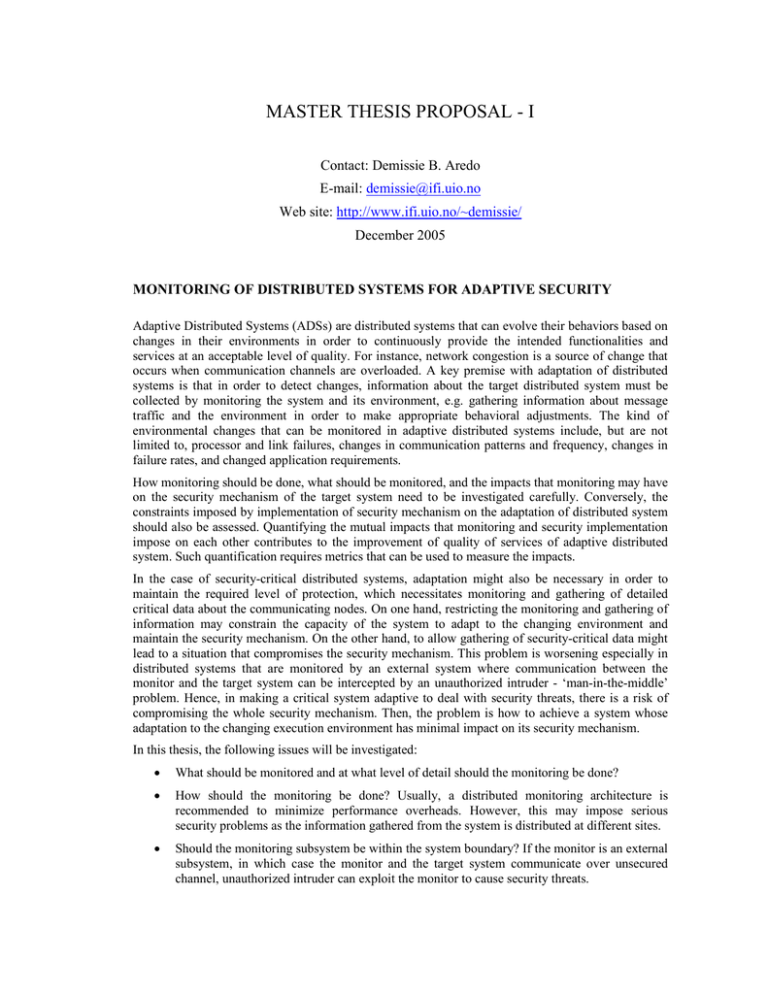
MASTER THESIS PROPOSAL - I Contact: Demissie B. Aredo E-mail: demissie@ifi.uio.no Web site: http://www.ifi.uio.no/~demissie/ December 2005 MONITORING OF DISTRIBUTED SYSTEMS FOR ADAPTIVE SECURITY Adaptive Distributed Systems (ADSs) are distributed systems that can evolve their behaviors based on changes in their environments in order to continuously provide the intended functionalities and services at an acceptable level of quality. For instance, network congestion is a source of change that occurs when communication channels are overloaded. A key premise with adaptation of distributed systems is that in order to detect changes, information about the target distributed system must be collected by monitoring the system and its environment, e.g. gathering information about message traffic and the environment in order to make appropriate behavioral adjustments. The kind of environmental changes that can be monitored in adaptive distributed systems include, but are not limited to, processor and link failures, changes in communication patterns and frequency, changes in failure rates, and changed application requirements. How monitoring should be done, what should be monitored, and the impacts that monitoring may have on the security mechanism of the target system need to be investigated carefully. Conversely, the constraints imposed by implementation of security mechanism on the adaptation of distributed system should also be assessed. Quantifying the mutual impacts that monitoring and security implementation impose on each other contributes to the improvement of quality of services of adaptive distributed system. Such quantification requires metrics that can be used to measure the impacts. In the case of security-critical distributed systems, adaptation might also be necessary in order to maintain the required level of protection, which necessitates monitoring and gathering of detailed critical data about the communicating nodes. On one hand, restricting the monitoring and gathering of information may constrain the capacity of the system to adapt to the changing environment and maintain the security mechanism. On the other hand, to allow gathering of security-critical data might lead to a situation that compromises the security mechanism. This problem is worsening especially in distributed systems that are monitored by an external system where communication between the monitor and the target system can be intercepted by an unauthorized intruder - ‘man-in-the-middle’ problem. Hence, in making a critical system adaptive to deal with security threats, there is a risk of compromising the whole security mechanism. Then, the problem is how to achieve a system whose adaptation to the changing execution environment has minimal impact on its security mechanism. In this thesis, the following issues will be investigated: • What should be monitored and at what level of detail should the monitoring be done? • How should the monitoring be done? Usually, a distributed monitoring architecture is recommended to minimize performance overheads. However, this may impose serious security problems as the information gathered from the system is distributed at different sites. • Should the monitoring subsystem be within the system boundary? If the monitor is an external subsystem, in which case the monitor and the target system communicate over unsecured channel, unauthorized intruder can exploit the monitor to cause security threats. • What are the impacts of monitoring for adaptation on security mechanisms implementation? Can these be quantified? What metrics can be used to quantify these impacts? It is definite that a monitoring component aims at becoming more knowledgeable about the environment it is functioning in so that the changes in the distributed environment can be detected and the corresponding actions can be taken in order to compensate for the changes in the environment for purposes of providing acceptable quality of service. However, considering the security threats that may occur in the case that an intruder takes control over the monitoring system, there needs to be a limit to the kind and level of knowledge that the monitoring system can be allowed to have. Also, access to the monitoring systems should be protected from the intruders. The more critical information the monitoring subsystem logs, the higher the risk for the security to be compromised is. For instance, if the purpose of the monitoring is to provide a better security mechanism by making the system adaptive to the changing environment, e.g. by capturing of intrusion attempts, the monitoring system should collect detailed and security-critical data such as user ID and IP address of a site. In that case, there is a high risk of information disclosure to unauthorized intruders. Hence, establishing a technique for finding the trade-off between collecting critical data to achieve a better adaptation and the risk of running into security threat is useful. This is among the research issues that must be investigated. Relevant References S. N. Bhatti (2005). Why quality? ISO 9126 software quality metrics (Functionality) support by UML suite. ACM SIGSOFT Software Engineering Notes 30(2). M. Swanson, N. Bartol, J. Sabato, J. Hash and L. Graffo (2003). Security Metrics Guide for Information Technology Systems, NIST special publication 800-55. W.-K. Chen, M. Hiltunen and R. Schlichting (2001). Constructing Adaptive Software in Distributed Systems. Proc. of the 21st International Conference on Distributed Computing Systems, (ICDCS21), pp. 635-643, Mesa, AZ. G. Russello, M. Chaudron, and M. van Steen (2005). Coordination Models and Languages. Proc. of the 7th International Conference, COORDINATION 2005, Namur, Belgium. F. M. Silva, Endler, and K. Fabio (2002). Dynamic adaptation of distributed systems. 16th European Conference on Object-Oriented Programming. E. S. Al-Shaer (1998). Hierarchical Filtering-Based Monitoring Architecture for Large-Scale Distributed Systems. PhD Thesis, Old Dominion University. J. Voas and K. Miller (1996). Defining an Adaptive Software Security Metric from a Dynamic Software Fault-Tolerance Measure. COMPASS '96, the 11th Annual Conference on Computer Assurance, Gaithersburg, Maryland. S. Kreutzer and S. L. Hakimi (1983). Adaptive Fault Identification in Two New Diagnostic Models. Proc. of the 21st Allerton Conference on Communication, Control and Computing, pp. 353-362. M. A. Hiltunen and R. D. Schlichting (1996). Adaptive Distributed and Fault-Tolerant Systems. International Journal of Computer Systems Science and Engineering, 11(5):125-133. U. Leonhardt and J. Magee (1998). Security Considerations for a Distributed Location Service, Journal of Network and Systems Management, 6(1):51-70. S. C. Payne (2001). A Guide to Security Metrics, SANS InfoSec Reading Room, http://www.sans.org/rr/whitepapers/auditing/55.php. F. José da Silva e Silva, M. Endler and F. Kon (2002). Dynamic Adaptation of Distributed Systems, the 12th Workshop for PhD Students in Object-Oriented Systems 16th European Conference on Object-Oriented Programming, Málaga, Spain.
